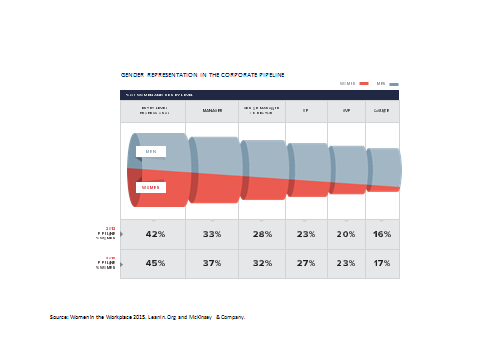"How many more reports do we need?" I asked myself as I read through the latest one documenting (again) the gap in gender parity in organizations. This particular report, "Women in the Workforce", featured a nice visual of how women are underrepresented at every level within organizations.
And, of course, at higher organizational levels women comprise an even smaller percentage of the workforce than at lower organizational levels.
Sigh.... I imagine two general responses: yawns from those for whom this conversation about gender equity has become tired and stale and frustration from those companies and executives who have been trying, for years, to achieve some sustainable change.
I have a suggestion--let's approach our intervention efforts to solve the equity problem with as much rigor and skepticism as we apply to our efforts to document the problem. What I am calling for here is "evidence-based change interventions."
What does that mean?
Imagine you have just learned you have high blood pressure. Your doctor offers that there are 3 different drugs from which you can choose to treat your condition. Would you take any of them without first investigating whether or not they actually work? Would you not want to be assured that they have been subject to rigorous, scientific investigation? Further, would you not want to know about how patients like you respond to each of these drugs? Of course you would investigate these drugs before putting them into your system. Yet, organizations typically and routinely do not investigate interventions to promote gender-equity before putting them into their systems. Rather, in their eagerness to "fix" any gender equity problems (which is a good thing), they invest in interventions that "sound right" or "feel" like they might work, but without testing and documenting whether or not the interventions actually do move the equity needle. For example, mentorship programs for women seem like a reasonable way for organizations to invest in women. Yet, research shows that many mentoring initiatives serve to make women feel better about the organization but do not help them advance within it. Moreover, organizations seem vulnerable to new "fads" in equity interventions. Fads, which like new "wonder drugs," are not likely to have been tested and are highly likely to fall short of their claims. As a result, collective progress towards gender parity has been hampered.
Recently the Georgetown University Women's Leadership Institute hosted an experimental workshop. It convened executives from 16 top companies and 10 leading scholars (labor economists and others who rigorously study the gender gap) to have a conversation about evidence-based change initiatives. Executives learned about what it might mean to test interventions (using control groups, randomized assignment of personnel to treatment groups) and scholars learned about the impediments to doing these sorts of investigations (legal concerns, data and privacy issues).
Challenges do remain, yet every one of the participants said they profited from attending, learned a great deal from other participants, would come back again and recommend attendance to a colleague. This path forward is actually quite clear; the challenges are to build trusting relationships within and across corporations and academia that pave the way to devise and carry out the experiments needed to rigorously test equity interventions. Collectively, we need to make the investment of time and effort both to overcome the obstacles and then to conduct the experiments and disseminate the results and evidence-based recommendations.

